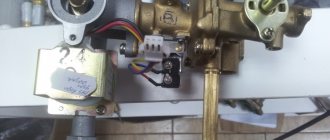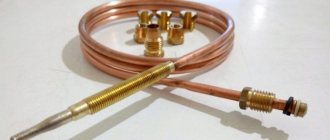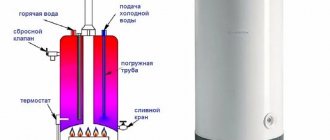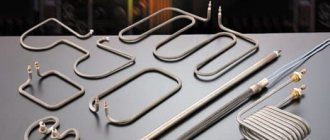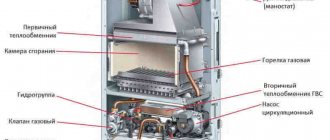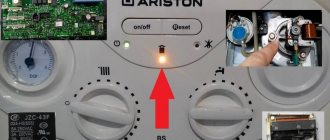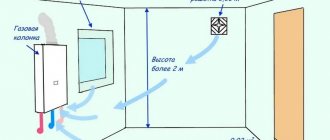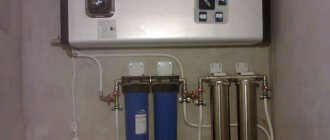If there is no hot water in your house or your hot water is constantly turned off, then life becomes completely uncomfortable. But this is not a reason to refuse a warm shower on a cool autumn evening, don’t you agree? This problem can be solved by installing a geyser, as many users do. But how does such a miniature water heater work and can it cope with its task?
We will talk about all this in detail in our publication - here we consider the principle of operation of a gas water heater and the diagram of its design. Attention is also focused on the main equipment malfunctions and ways to cope with them. The presented material is supplemented with visual illustrations, diagrams and videos.
General structure of a household water heater
A geyser is a flow-through water heating device. This means that water passes through it and heats up as it goes. But, before moving on to an analysis of how a household gas water heater works, let us recall that its installation and replacement are associated with a centralized gas supply system.
Therefore, you must submit documents to the gas service of your region along with the appropriate application. You can read about the norms and necessary documents in our other articles, but now let’s move on to the device.
Different models of geysers differ from each other, but the general structure of a household geyser looks something like this:
- Gas-burner.
- Igniter/ignition system.
- Exhaust hood and connection to the chimney.
- Chimney pipe.
- The combustion chamber.
- Fan (on some models).
- Heat exchanger.
- Gas supply pipe.
- Water node.
- Connections for water supply.
- Pipe for hot water outlet.
- Front panel with controller.
The central element of the column is a gas burner , in which gas combustion is maintained, which helps to heat the water. The burner is installed in a housing; hot combustion products are collected in it, the purpose of which is to heat water.
The housing is made of metal and completely covers the front and sides of the speaker. It is important that the material of the housing conducts heat well, because the quality of heating depends on the transmission of heat.
Structural components of a geyser located inside the housing. Closed type gas equipment is shown here
On top of the apparatus there is an exhaust hood and a chimney through which combustion products leave the column and the room. Their design depends on whether the column is open or closed, which will be shown below.
The pipes meander like a coil inside the body, water passes through them under natural pressure and is warmed by hot gases. This entire pipe system is called a heat exchanger . At the bottom there are two pipes: on the right - for receiving cold water from the pipeline, on the left side hot water flows out.
A filter is often installed between the water supply network and the gas water heater , which regulates the hardness of the water. Without a filter, the column may become covered with scale at high water temperatures. When entering the column, water passes through a water node , which serves as a kind of “connection” between the water flow and the gas flow. We'll talk about this connection a little further.
Burning gas burner with electric ignition and flame sensor. Sensors play an important role in the functioning of equipment. We'll talk about their functions further.
Using another tube, which is also located below, the column is connected to the gas main.
There is also a front panel with a control unit . It is equipped with regulators to control gas and water consumption. Depending on the model, these can be either simple knobs that need to be turned, or liquid crystal displays, where you can see many characteristics of the column, or even the nature of its malfunction if the column does not work.
Turning on the device
The first step is to install the batteries. To do this, open the battery compartment and install them, observing the polarity. Then you need to open the cold water and gas valves. Open the hot liquid tap on the nearest faucet.
At the moment when the liquid flows through the water unit, a spark ignition occurs and, thanks to this, the burner ignites. If it is turned on for the first time or after a long period of inactivity, air may accumulate in the gas line; in order to remove it, you will need to open the mixer several times, hold it for a minute, and then close it.
If the burner ignites, you need to turn the water pressure adjustment lever (located on the right) to the right, this will make it possible to turn on the Vektor JSD 20 device when the liquid pressure in the system has decreased.
How does a geyser work?
Let's get acquainted with the principle of operation of a gas water heater in the form of a simple algorithm:
- when water flows through the water assembly, the membrane tenses and moves the rod connected to the gas valve upward;
- then the valve opens the gas supply to the main burner;
- the gas is ignited from an electrode or igniter, burns and heats the water that flows through the heat exchanger pipes;
- the heated water flow is supplied to the tap through the left pipe;
- gas combustion products are removed through a chimney or hood - there is a fundamental difference between open and closed type columns, which will be discussed in detail below.
At the same time, the power of the flame and the power of water flow through the column can be adjusted using the controls on the front panel.
Now let’s take a closer look at how the burner is ignited and how the already mentioned water unit is connected to this.
Structural elements and operating principle of the water unit. In common parlance it is called "frog". In the figure, yellow arrows show the direction of gas movement, blue arrows show the direction of water movement
Gas ignition method
In general, geysers are based on three methods of igniting gas. As can be seen in the diagram, in all three cases the signal to ignite the main burner is the reaction of the water unit (frog).
Here are three ignition methods:
- using a piezoelectric element;
- from batteries;
- from the rotation of the hydraulic turbine.
Piezo ignition is a manual ignition and requires a button on the front panel. Pressing the button causes the piezoelectric element to close, which ignites the igniter. He, in turn, ignites the main burner after a signal from the rod, which moves the water membrane with active water pressure.
The igniter continues to burn with a small flame until it is turned off manually. This leads to increased gas consumption and increased scale formation in the pipes. One of the gas instantaneous water heaters with manual ignition is the Bosch Therm 4000 OW 10-2 P.
Scheme of a gas water heater with piezo ignition. The figure shows the “insides” of the speaker - the main structural components located inside the case, and the buttons/knobs located outside
Some models of geysers operate on batteries . In this case, ignition occurs from an electric spark after a signal from the rod. Thus, instead of an igniter, there are electrodes that directly ignite the main gas burner.
But batteries need to be changed on average once every 10 months, and with constant use - once every 2 months, so that there are no unforeseen circumstances. One such battery-powered speaker is the Zanussi GWH 10 Fonte Glass La Spezia.
Sometimes ignition occurs from the rotation of a hydraulic turbine (with water flow). Ignition also occurs from an electric spark, but there is no need to change the batteries, because the turbine itself generates electricity as water flows.
But for the hydraulic turbine to operate, high pressure in the pipes is required, at least 0.3 bar. Not every home has such pressure. In Russia and other CIS countries, it is not recommended to buy such speakers due to unstable water pressure. An example of such a model is the Bosch Therm 6000 O WRD 15-2 G geyser, which is noticeably more expensive than the two above models.
Column water unit design
The design of the water unit is of particular interest. Its structure can be seen in the diagram below, the labels for the details are below the diagram. The remaining designated elements are used for fastenings.
Structural elements of the repair kit for the water unit of the Neva brand geyser: 1) silicone membrane D 54 mm; 2) gland for cold water supply fitting 19x14x2.5 mm; 3) drain valve seal 10x6x2 mm; 4) water flow regulator oil seal 14.5x9.5x2.5 mm - 2 pcs.; 5) rod seal gland thread M 12 x 1 5.34x1.78x1.78 mm - 2 pcs; 6) rod sleeve seal seal M 12 x 1 14x11x1.5 mm; 7) oil seal for the sub-diaphragm pressure regulator screw 6.4x2.6x1.9 mm; water flow regulator screw seal 7xx3.2x1.9 mm; 9.) seal for connecting the water and gas units 27.5x23.5x2 mm; 10) seal for connecting the water-gas unit with the burner 18x13x2.5 mm; 11) water temperature sensor oil seal 10x6x2 mm
2) gland for cold water supply fitting 19x14x2.5 mm; 3) drain valve seal 10x6x2 mm; 4) water flow regulator oil seal 14.5x9.5x2.5 mm - 2 pcs.; 5) rod seal gland thread M 12 x 1 5.34x1.78x1.78 mm - 2 pcs; 6) rod sleeve seal seal M 12 x 1 14x11x1.5 mm; 7) oil seal for the sub-diaphragm pressure regulator screw 6.4x2.6x1.9 mm; water flow regulator screw seal 7xx3.2x1.9 mm; 9.) seal for connecting the water and gas units 27.5x23.5x2 mm; 10) seal for connecting the water-gas unit with the burner 18x13x2.5 mm; 11) water temperature sensor oil seal 10x6x2 mm
The main working parts are the rod and the diaphragm , under the influence of which it moves when water flows in the lower part. The rod opens the valve and allows gas to flow into the burner, which is then ignited.
Another working element is a PVC ball that serves as a fuse. It stops the flow of gas during sudden pressure changes in water pipes - hydraulic shocks, which we will also talk about later.
Combustion chamber type
Based on the design of the combustion chambers, there are two types of geysers: open and closed.
Columns with an open combustion chamber have open air access to the burner, and combustion products go into the exhaust hood.
Such models are simpler than turbocharged ones, which will be discussed below, their operation is almost silent and in most cases they do not require electricity. However, due to the open connection between the combustion chamber and the room, air pollution in the room is possible if the hood is not working properly.
Columns with a closed combustion chamber are turbocharged. The combustion chamber in them is sealed, in addition to the channels for air injection and exhaust. It is pumped there by a fan through coaxial pipes and goes out into the street through the chimney, along with the combustion products.
Such columns are usually fully automated, they do not have manual controls, and the traction and temperature sensors in them are more sensitive. These speakers are “modern” and safer.
The illustrations above showed a gas water heater with a closed combustion chamber. For comparison, in the following illustration you can see the arrangement of two types of speakers side by side. You will find many similar elements in them, but the principle of removing combustion products is noticeably different.
Comparison of combustion chambers in columns. The combustion chamber of the open type column is shown on the left. On the right is a gas water heater with a closed combustion chamber, where air is forced into the chamber using a fan
Principle of operation
To understand the principle of operation of a geyser, you must first consider what security system it is equipped with. When the unit is in the off state, the control unit (16) does not receive electricity, since the circuit is broken in the microswitch (15). The switch plate is pressed by the pusher, and while this happens, it is in the off state.
The solenoid valve (19) is also closed and cuts off the gas supply from the inlet pipe, since it is not receiving power. But this is not the only place that shuts off the gas - it is also shut off using a spring valve, which is located in the gas module (35). The inoperative state of the valve is characterized by pressing the disc gasket against the seat, which ensures complete shutoff of the supply of the combustible mixture to the manifold.
The water section consists of a two-chamber module (36), colloquially called a “frog”, with an elastic rubber membrane. Using a special channel, the “frog” cameras can communicate. When the water supply is turned off, the pressure in the chambers is equalized and the membrane is in an equilibrium position.
The principle of operation of a gas water heater
Water is supplied to the heat exchanger through the bottom of the chamber. At the top there is a rod with a plate made of plastic, which is adjacent to the membrane. The rod comes out through a hole in the middle, towards the gas block. Opposite this rod, in the gas module, there is the same one, but connected to a spring valve, to which is attached a pusher coming from the switch.
What happens when the water starts
How does a gas water heater work if you dig up water? When you open a water tap at the point of consumption (water intake), the following happens.
- When a liquid flow passes through the “frog”, a vacuum is created in its chamber. The rubber membrane, under the influence of increased pressure, bends and pushes the plate out. The latter transmits the pushing movement to the rod. The water module rod pushes the opposite gas module rod (37).
- Next, the pusher, which is connected to the rod, no longer holds the switch plate, and it is released. In this case, the switch closes the circuit, and power begins to flow into the electronic control module from the battery section.
- The movement of the rod also forces the spring of the mechanical valve to depress, as a result of which the plate moves away from the seat, and the gas supply channel to the manifold becomes open.
- The solenoid valve, receiving power from the batteries, opens and does not interfere with the passage of gas through the spring valve towards the manifold.
- Meanwhile, the control unit generates and sends an electrical impulse to the spark plug (23) to create a spark discharge that can ignite the flame. When all components operate normally, the burner lights up.
The ignition process is controlled by an ionization sensor (24). If the burner does not ignite within 6-7 seconds, then, in order to avoid the accumulation of a high concentration of an explosive mixture, the electronic module, without receiving a pulse from the sensor, will shut off the gas supply. If there is combustion, the sensor will generate a pulse to turn off the spark plug. If, after the water heater starts operating, the flame goes out, then the impulse from the sensor will stop coming to the control module, after which it will immediately respond to this by shutting off the gas using the solenoid valve.
Performing all these functions in the Neva gas water heater is possible only if one condition is met: the circuit between the two sensors must not be broken, namely, between the outlet water temperature control sensor (29) and the draft sensor (32). These relays are connected in series and their contacts are closed when the sensors are operational. Therefore, in order for the control module to receive power, both sensors must complete the circuit.
If a weak draft is formed in the smoke exhaust unit, then the combustion products, due to the special design of the exhaust unit, cannot pass towards the central channel, and are directed to the side cavities. Since the temperature sensor is located on the left, it will “detect” a sudden rise in temperature, breaking the power supply circuit to the control module. This will stop the supply of the combustible mixture and turn off the burners.
By analogy, the relay, which is located on the pipe for removing heated water from the heat exchanger, is also activated. When the water heats up to 90°C, and this is considered a critical level, the power supply circuit of the electronic unit will be broken.
Work when the water is turned off
When the water supply is turned off, the following happens.
- The pressure in the “frog” chambers is balanced. Returning the rubber membrane to its place causes the plate connected to the pusher to move in the corresponding direction to the initial position.
- When the rod returns, the poppet valve is released, reliably shutting off the fuel supply.
- At the same time, the pusher begins to press the switch plate, as a result of which the circuit supplying the control module breaks.
- Since the solenoid valve does not receive electricity after the control unit is turned off, it also closes.
Thus, turning off the water triggers a chain of processes that automatically turn off the water heating device. For clarity, the photo below shows the main components of the unit (bottom view) that affect its operation (the numbering has been preserved and a new position has been added, number 40 is the microswitch pusher).
Main components of a gas water column
The information display (38) is also connected to the electronic control circuit of the water heater and the temperature sensor (39) on the outlet pipe using several wires. The display plays only an informational role and is not involved in the operation and configuration of the gas water heater.
The unit can also operate when the LCD display is turned off, for example, after removing the outer casing on which it is attached.
To summarize the above, we can say that the geyser is a fairly complex and reliable device to operate. Over the many years of existence of these units, their design has changed little, except that for more convenient control, electronic control and monitoring units began to be used in the devices.
Main characteristics of the speakers
Now let's talk about the practical aspects of using the speaker. One of the main characteristics is performance . It directly correlates with power, which is indicated in kW and shows the volume of water heated per minute by 25 °C.
The characteristics are usually indicated in the device passport. A regular water heater heats 10-20 liters of water per minute at 25 °C, although this value can vary significantly.
Another characteristic of modern speakers is power modulation . It shows how the power of the column can change depending on the flow of water and is measured as a percentage of the initial power.
For modulation, the columns are equipped with special fittings with a membrane, which changes the gas supply to the burner depending on the flow. Modulation in the range of 40-100% of the device power is considered normal.
The diagram shows the modulating valve and the principle of its operation, which is similar to the operation of a water unit and its membrane
Types of boilers
Storage water heaters are either electric or gas . Both types are very similar in operating principle and internal structure. However, some indicators still differ. Let's look at the advantages and disadvantages of a gas boiler over an electric one.
- Higher efficiency. Gas storage devices heat water several times faster than electric ones.
- Gas boilers are slightly cheaper.
- Cheap to operate. Natural gas is an inexpensive fuel, which is not the case with electricity.
Flaws:
- Safety. A gas leak, although unlikely, is, however, an extremely undesirable and dangerous phenomenon.
- The process of installing a gas boiler is much more troublesome and expensive.
Safety sensors and their meaning
A geyser can be dangerous, because it is connected simultaneously to water and gas mains, each of which individually can pose a threat.
If there are problems with the gas or water supply, safety sensors turn off the operation of the column, and special valves will shut off the water or gas supply.
Typically, geysers can withstand voltages of up to 10-12 bar, which is 20-50 times higher than normal pressure in pipes. Such sharp jumps are possible with so-called hydraulic shocks.
But if the pressure is lower than 0.1-0.2 bar, then the column will not be able to work. You need to carefully study the instructions and specifications before purchasing to understand whether the dispenser is optimized for low water pressure in pipes in the CIS countries and whether it will work properly. And vice versa - will it withstand sudden changes in pressure, which, alas, is also not uncommon in our conditions.
Ignition circuit for a burner powered by an electric spark. Locations of the main safety sensors for a household geyser
In general, a modern geyser contains many safety sensors. All of them, in case of breakdown, can be replaced.
More details about the purpose and location of the sensors are in the table below.
| Sensor name | Location and purpose of the sensor |
| Chimney draft sensor | Located in the upper part of the device, connecting the column with the chimney. Turns off the column when there is no draft in the chimney |
| Gas valve | Located in the gas supply pipe. Turns off the column when gas pressure drops |
| Ionization sensor | Located in the device camera. Turns off the device if the flame goes out while the gas is on. |
| Flame sensor | Located in the device camera. Shuts off the gas if the flame does not appear after ignition |
| Relief valve | Located on the water supply pipe. Turns off the water when the pressure in the pipeline is high |
| Flow sensor | Will turn off the column if water stops flowing from the tap or if the water supply is turned off |
| temperature sensor | Located on the heat exchanger pipes. It will block the burner operation if the water is significantly overheated to avoid damage and burns (mainly triggered at +85ºС and above) |
| Low pressure sensor | Will not allow the column to turn on when the water pressure in the pipes is low. |
What should you consider when choosing a water heater?
A household gas water heater is not a boiler for heating and it is difficult for the average user to choose it based on power. It is much clearer when it comes to the amount of water heated. This value is indicated in the technical data sheet of the product of any manufacturer and is expressed in liters per minute when heated to 25 °C.
For clarity, we present a table with data on water heaters of the Russian brand Neva, showing the dependence of performance on the thermal power of the unit:
Reference. Dispensers for DHW needs are inferior in efficiency to gas heating boilers by 3 to 5 percent. If the efficiency of an atmospheric heater is about 88%, then the efficiency of the same water heater is 84%. But it is impossible to feel this difference in practice.
When choosing a device for heating water, you first need to determine its performance. Next, we suggest following simple recommendations:
- If your budget is limited, and electricity is often cut off in your area of residence, then a simple non-volatile atmospheric model is just what you need. The ignition system is from a piezoelectric element or battery-powered; they last quite a long time (2-3 months with intensive use).
- In most apartments it is impossible to install atmospheric speakers due to the lack of chimney ducts, and the removal of combustion products into ventilation shafts is prohibited. No problem, buy a turbocharged water heater with a coaxial chimney that goes outside directly through the wall. Just determine the location of the pipe exit and coordinate it with your neighbors. Read more about connecting chimneys to gas water heaters in this article.
- In our conditions, when the water supply networks are worn out, it is better not to install devices with ignition from a hydrogenerator. The latter can quickly fail due to poor water quality and water hammer in pipelines. To protect the generator, you will need a water reducer, and this is an additional expense.
- Try to select modern modifications of devices where the igniter does not burn around the clock. It slowly but surely consumes gas, destroys the front wall of the heat exchanger and smokes onto the front panel.
Basic problems and ways to fix them
Speaking about the structure and operating principles of a household geyser, as well as the sensors built into it, it is worth briefly mentioning possible failures and malfunctions. Here we will not dwell on a complete repair or replacement of the column, but will quickly go through all the elements listed in the burner description and describe their problems, as well as ways to deal with them yourself.
As already mentioned, the main element of the column is a gas burner . Often the burner goes out due to the activation of the safety sensors, which we have already discussed. Frequent problems that lead to this scenario are contamination of the heat exchanger with soot and scale.
The reason for the low pressure is the formation of scale in the heat exchanger pipes. In this case, you need to remove the heat exchanger and rinse the pipes with special liquids to remove scale.
This photo shows a dirty heat exchanger. In this case, you need to remove it and clean out the soot. If the column is located close to the stove, the heat exchanger may also be contaminated with food fats
If gas combustion does not occur completely, or the column is used for a long time, soot accumulates in the chamber on the outside, which significantly reduces the thermal conductivity and quality of water heating.
To learn more about the causes of low pressure and the intricacies of cleaning, please follow this link.
If the gas valve does not open due to low pressure of the supplied water, you need to remove the filter , check how clogged it is and, if necessary, wash it. If there is insufficient water or gas pressure, you will have to contact the appropriate government service.
If water flows directly from the column, this means that the tightness in the pipes is broken . It is necessary to disassemble them and replace the sealing elements. If necessary, the pipes themselves will have to be replaced.
Separately, it is worth recalling the malfunction of the water membrane . If the column is in use for a long time, the membrane of the water unit wears out and its sensitivity drops significantly. It stops responding to low water pressure, and, accordingly, does not give a signal that the burner needs to be lit. At best, it should be changed every 5-6 years.
When the membrane is worn out, you can purchase a repair kit and replace it yourself. The water unit consists of such basic elements as a rubber membrane, a lid, a housing and a plastic plate with a spring
Sometimes the problem is also in the rod , which is moved by the membrane; it can also be replaced if necessary, because there are special repair kits for this.
To better understand the design of your gas water heater model, you need to carefully study the instructions for use and the object’s passport. This will not only save your time and nerves, but will also improve your understanding of how the device works.
Common faults
Like any gas-using equipment, the hot water column must be serviced and repaired by a specialist in this field. But there are a number of simple faults that the owner of a private house or apartment can fix on his own. The most common problems with instantaneous water heaters are:
- The igniter does not ignite.
- The wick burns, but after opening the tap the main burner does not turn on or ignites, but immediately goes out.
- There is insufficient water heating.
- Water begins to drip from the bottom of the case.
There can be many reasons for the occurrence of the listed symptoms, but we will indicate the most obvious ones, which the user can eliminate with his own hands.
The draft in the chimney should be checked regularly, as shown on the left. On the right is cleaning the heat exchanger from scale when the column does not heat the water.
It often happens that the igniter does not ignite due to a trivial reason - the batteries are discharged.
The cause of burner extinguishing may be:
- lack of draft in the chimney channel;
- faulty traction sensor or poor contact in its wiring;
- leaky membrane of the water unit;
- Inlet filter clogged (if equipped).
Low temperature of the leaving water, which happens after several years of operation, is usually associated with the appearance of scale in the heat exchanger and it will have to be washed. But drops of water from under the housing indicate a leak in some connection, safety valve or heat exchanger itself. The reason is the device overheating when the water is turned off.
Malfunction with overheating is inherent in atmospheric geysers. The mechanism is as follows: when the water is suddenly shut off and the burner is turned off, the heat exchanger remains hot, boiling occurs in it and steam is formed. If the situation is constantly repeated, the steam will eventually break out, breaking the weakest seal. Hence the recommendation: in such devices you must first turn off the gas and then turn off the water.
Conclusions and useful video on the topic
To consolidate your understanding of the structure of a gas column, you can watch a video review that explains in detail the location of all elements of the column using a live example:
In this material we studied the structure of a household geyser and the principle of its operation. Then we looked at the operation of the main elements. And knowing the main components and elements of gas equipment, the sensors of its safety system, you can diagnose the breakdown on your own. And if the cause of the malfunction is contamination of individual structural elements, then perform manual maintenance of the gas water heater.
Would you like to supplement the above material with useful recommendations or ask questions that we have not touched upon here? Ask for advice from our experts and other site visitors - the feedback form is located below.
The gas makes a loud noise when burning in the wick.
After installing the Neva-3208 gas water heater, an unpleasant phenomenon appeared that did not affect the quality of the water heater. When the gas burned in the wick in standby mode, it produced a rather loud sound, which was unpleasant to the ear and created discomfort. After some thought and experimentation, I managed to get rid of the noise in a simple way. He assumed that a stream of gas in the burner under pressure, escaping from the nozzle and hitting the wall at the bend of the burner, creates conditions for noisy combustion.
To test this assumption, I inserted a strip of tin approximately 3 cm long and 5 mm wide into the burner, the main thing being that it fit inside the burner. The noise disappeared. If your gas water heater is also noisy, then you can take any metal strip, for example, cut it from a tin can, make a hole in it at the edge, put the strip on a straightened paperclip bent at the end and put it into the burner. The result will be something like a fishing lure. The paperclip is needed so that you can remove the strip of metal back from the burner if the noise does not disappear, although if it burns normally, you don’t have to remove it. This experiment can be carried out without even removing the casing from the gas water heater.

